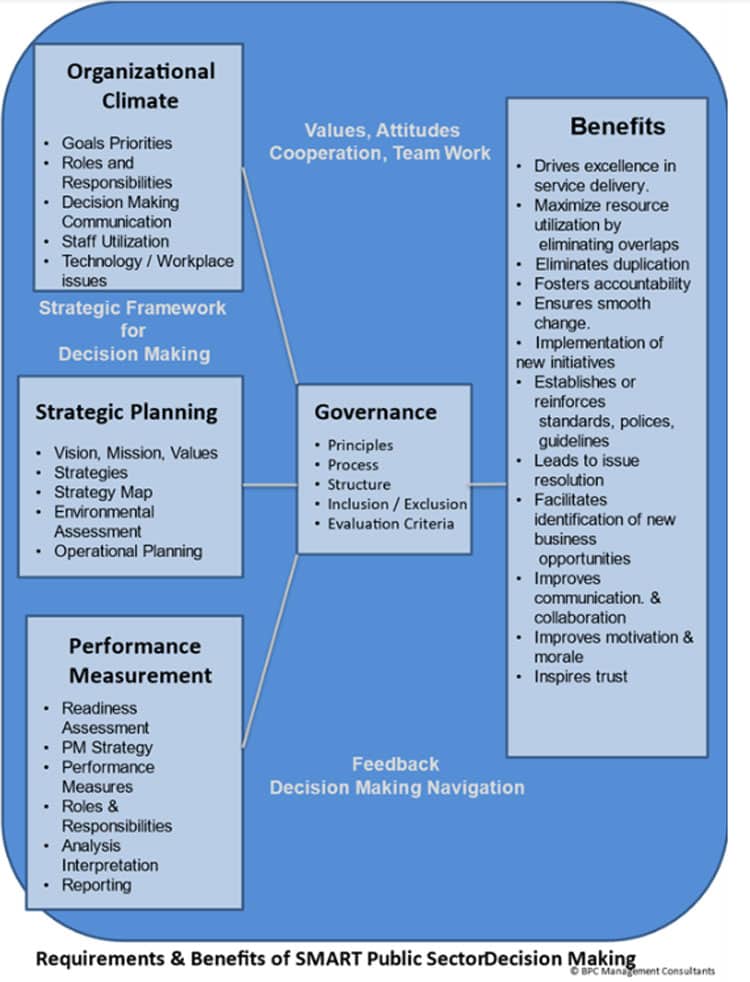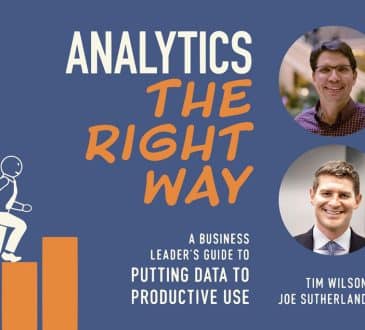Smart Decision Making in the Public Sector

At what point will the suboptimization of public sector resources no longer be tolerated? At what point will the growing financial needs to address healthcare, education, environmental issues, and others force radical changes in public sector resource allocation approaches?
Today many (need I say most) organizational changes have been triggered by environmental disasters, man-made catastrophes, health crises, financial crises, corruption, etc. In most cases, the solutions provided are reactive rather than proactive.
Why do poor public sector decisions result in the suboptimal use of public sector resources? Here is a list of what happens with weak decision-making:
- Duplication of effort
- Poor transparency
- Inefficient decision making
- Inability to realize optimization opportunities
- Poor quality client service
- Inability to resolve major issues
- Inability to identify business opportunities
- Poor change management practices
- Lack of organizational standards, policies, and guidelines
- No innovative business practices,
- Behavioral consequences that include lack of leadership, reduced communication, lower morale/motivation, and reduced productivity
The Public Sector spends more resources than any other organization in the world and wastes more resources than any other organization in the world. Approximately half of these resources are spent on human resources and the other half on information technology (IT) and public works projects, etc. Auditor reports at the city, state, and national levels in developed and developing countries all over the world document the billions of dollars wasted annually as a result.
Existing approaches to public sector decision making don’t work. We need a way to make SMART public sector decisions.
The focus of this article is SMART decision making and is focused on large scale projects for IT and public works. Many of these large-scale projects fail to be delivered within the mandate of their original plan.
Mandate for Delivery of Large-Scale Projects
| Budget | Schedule | Scope | Functional Quality | Technical Quality |
| Delivered within the Project Budget | Delivered within the Project Schedule | Delivered according to Project Scope | Delivered the required functionality as outlined in project requirements and specifications | Delivered the required technical quality for service reliability, safety, security etc. |
How do we change the script in the public sector spending to enable smart decision making?
Stages of an Innovative Change
There are four stages of change to implement any innovation. These stages are:
- Awareness of the problem.
- Understanding the dimensions of the problem.
- Acceptance of the need to make a meaningful innovative approach.
- Use of a meaningful approach to enable smart public sector decision making.
At this point, it is obvious that we are aware, understand, and accept the need for a new approach to smart public sector decision making. The critical question is Stage 4 – to define a new approach to smart public sector decision making.
So, What Are the Requirements for Smart Public Sector Decision Making?
- Governance principles establish the framework and doctrine that govern behaviour of all participants interacting in making decisions for the benefit of the organization.
- Defined governance roles and responsibilities ensure committees operate smoothly and effectively. For this to happen the purpose of each committee must be clearly stated. Each committee must have a mandate that is complementary to the mandates of other committees. Each committee must include criteria for membership to ensure its members are qualified to carry out their responsibilities. Their participation in the committee must be sacrosanct. Meeting schedules and meeting procedures must ensure the focus of meetings is to make decisions and not share information.
- An effective governance process must provide consistent decision making, apply accountability, transparency, delegate authority, and make timely/efficient decisions. It must also identify cost savings and opportunities to apply best practices. In short, it outlines what information, in what format, and within what timeframes the information must be submitted at each step of the decision-making process. It is independent of personality and personal interests.
- Governance Evaluation criteria provide a transparent and impartial way of deciding which initiatives or funding proposals merit being approved in relation to others.
- Inclusion Criteria determine which initiatives should be managed from an organization wide perspective and which should be managed from a business line perspective. Exclusion Criteria determine which initiatives are not subject to the governance process because they require immediate attention or are within the authority of senior management, e.g. health and safety initiatives.
Beyond governance three other vital elements are required to make SMART public sector decisions:
- There must be a business plan. The strategic direction from the business plan provides the framework for decision-making throughout all aspects of organizational functioning, including finances, services, employees and clients Organization-wide decisions must be made within the context of the organizations Multi Year Plan to ensure that all initiatives support the vision, mission, strategies and the strategic outcomes of the organization. Project proposals are chosen because they benefit the organization as a whole rather than projects that enhance the reputation of a particular function or individual.
- There must be a performance measurement system in place to provide the ongoing feedback needed to adjust organizational operations as a result of ongoing changes to the internal and external environment. The Performance Measurement System also provides comprehensive information on project objectives – its budget, schedule and scope and on project functionality and technical quality. Periodic client satisfaction surveys are also required to capture broader project management issues.
- Both the business plan and performance measurement take place within an Organizational Climate and that determines the behaviour of the organization. The level of cooperation/teamwork directly influences employee cooperation, teamwork, motivation, and productivity.
The following diagram illustrates the requirements and benefits of Smart Public Sector Decision Making.

What Will Trigger a Major Change in Smart Public Sector Decision Making?
Successful examples of Smart Public Sector decision making, and the optimal use of public sector resources are a rare phenomenon today.
In its place, management decisions are often made to serve the interests of a function or manager rather than the organization. In many cases, the profession of a public servant as a dedicated and professional serving the public is being replaced with a culture of personal benefit.
The requirements for Smart Public Sector decision-making have been outlined here including:
- A Business Plan
- Performance Measurement System
- A supportive Organizational Climate
- The five components of governance
The five components of governance:
- Governance Principles
- Governance Roles and Responsibilities
- Governance Process
- Inclusion/Exclusion Criteria
- Governance Evaluation
These elements are critical to Smart Public Service decision making. But the maximum value of these elements will only be achieved once there is a change in the culture of the public service. Decisions must be made with the same gravitas that is used in their personal domain.
See the book The 3P Approach to Governance in the Public Sector by Bryan Shane and Patrricia Lafferty for more information on this subject.
Written by Bryan Shane.
Have you read?
Countries with the most gold reserves.
World’s Best Public Relations Agencies (Top PR Firms).
Countries with the highest human freedom.
World’s Safest & Most Dangerous Countries For Travelers.
Longest and Shortest Life Expectancies in the World.
Bring the best of the CEOWORLD magazine's global journalism to audiences in the United States and around the world. - Add CEOWORLD magazine to your Google News feed.
Follow CEOWORLD magazine headlines on: Google News, LinkedIn, Twitter, and Facebook.
Copyright 2025 The CEOWORLD magazine. All rights reserved. This material (and any extract from it) must not be copied, redistributed or placed on any website, without CEOWORLD magazine' prior written consent. For media queries, please contact: info@ceoworld.biz








